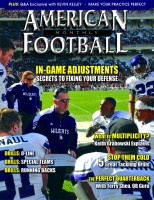Article CategoriesAFM Magazine
|
Strength Report – New Mexico Military Institute’s Strength Programby: Joe ForchtnerHead coach and Director of Human Performance, NMMI © More from this issue Before we designed our program, we sat down and discussed what advantages and limitations New Mexico Military presented us with as far as training our athletes. Our goal, obviously, was to maximize our advantages and minimize the effects of our limitations. The advantages were: 1) structure – we knew that our kids were going to be at workouts and we knew they were not going to stay out all night partying, 2) support of the coaching staffs – our coaching staffs have faith in us and are willing to let us try new/unconventional things. The disadvantages were: 1) strict schedule/weight room availability – all athletic teams train during the same block of time, 2) rest/recovery – our students wake up every day at 6 AM. Weight room availability limited the amount of time that we could physically get into the weight room. At that ti....The full article can only be seen by subscribers.
|
|
|||||||
| HOME |
MAGAZINE |
SUBSCRIBE | ONLINE COLUMNISTS | COACHING VIDEOS |
Copyright 2025, AmericanFootballMonthly.com
All Rights Reserved





